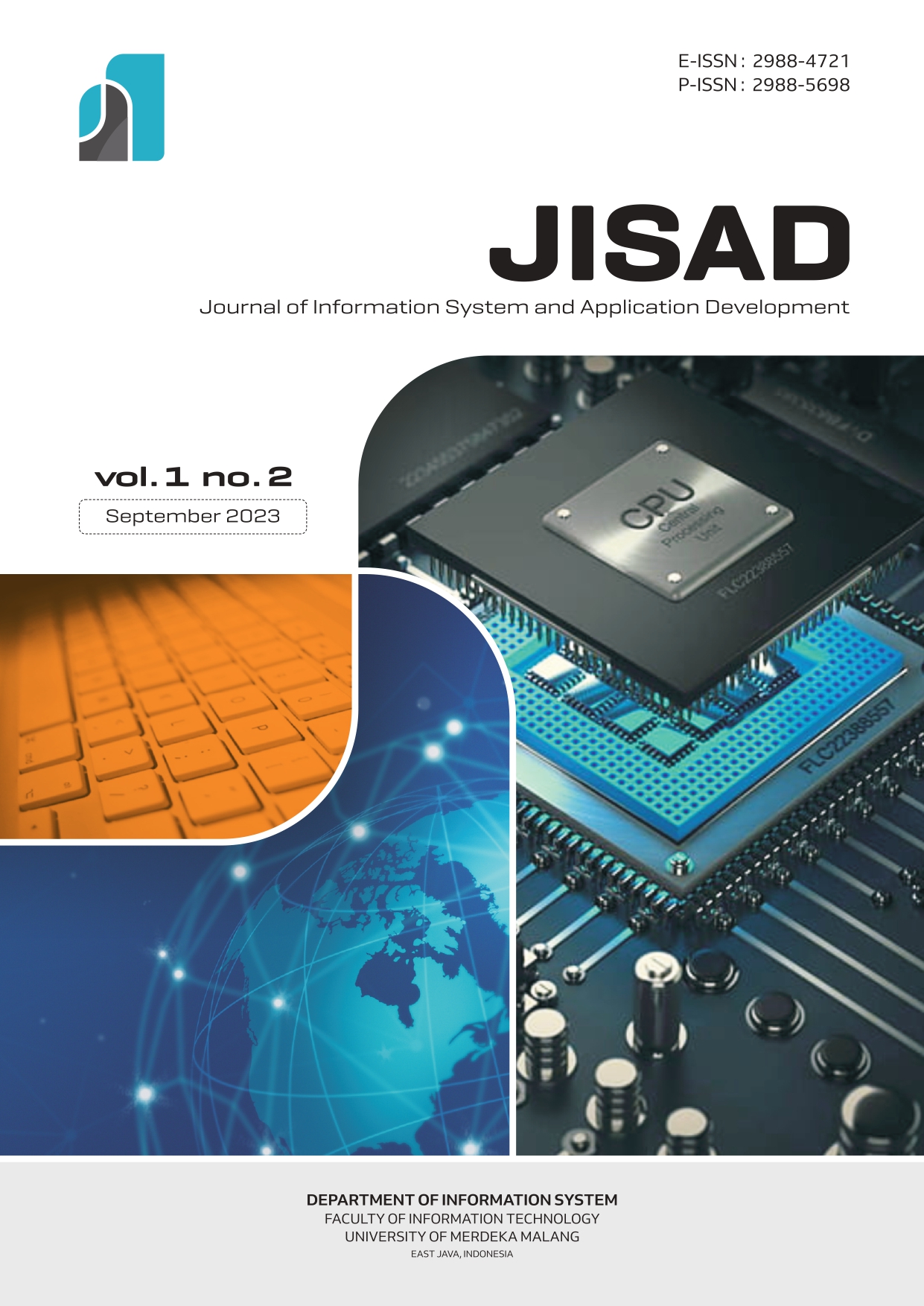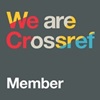Implementasi Electronic-Know Your Customer pada aplikasi Fintech untuk meningkatkan keamanan akun user
DOI:
https://doi.org/10.26905/jisad.v1i2.11112Keywords:
Electronic-Know Your Customer, application security, agile development methodAbstract
The information technology development can make financial transactions easier, but the security of Fintech applications such as Bangbeli is a critical issue that can be addressed through the implementation of the Electronic-Know Your Customer (E-KYC) feature to increase user trust. The aim of this research is to apply E-KYC technology as an additional feature in the Bangbeli application at PT. Doa Anak Digital. The approach used is the agile development method which consists of six stages, including requirements, design, development, testing, implementation and review. This research uses a qualitative approach, involving interviews with selected sources to ensure that the E-KYC feature can improve user account security. Implementation includes coding and implementing E-KYC in the Bangbeli application, followed by testing using the blackbox method to identify errors or bugs in the E-KYC system. The results of the research show conformity with the initial design, with features that run according to their function. As a result of interviews with users and Bangbeli regarding the implementation of the E-KYC feature, a number of feedback were obtained including an easy to understand flow, innovations that increase security, confidence in sending personal data, and the impression that this platform cares about user security.
Downloads
References
[1] A. M. M. Pratama, M. A. Puspa, and T. Djibran, “Perancangan Sistem Informasi Promosi Industri Kecil Menengah (IKM) Berbasis Android Di Kota Gorontalo,” J. Inform. Upgris, vol. 7, no. 1, 2021, doi: 10.26877/jiu.v7i1.6993.
[2] A. B. Permana, D. D. Anggraeni, N. R. G. Sulistyaningrum, S. Salamah, and Z. A. Jauhari, “Analisis Faktor yang Mempengaruhi Minat Penggunaan E-Wallet sebagai Alat Transaksi pada Mahasiswa Fakultas Ekonomi Universitas Negeri Semarang,” J. Potensial, vol. 1, no. 1, 2022.
[3] R. Safitri and M. Andriansyah, “Analisis Penerimaan Teknologi Keuangan (Fintech) Terhadap Penggunaan Aplikasi Fintech OVO,” J. Mitra Manaj., vol. 4, no. 4, 2020, doi: 10.52160/ejmm.v4i4.369.
[4] A. R. Muttaqin, A. Wibawa, and K. Nabila, “Inovasi Digital untuk Masyarakat yang Lebih Cerdas 5.0: Analisis Tren Teknologi Informasi dan Prospek Masa Depan,” J. Inov. Teknol. Dan Edukasi Tek., vol. 1, no. 12, 2021, doi: 10.17977/um068v1i122021p880-886.
[5] S. R. P. Sari and Anisah, “Pengaruh Kemanfaatan, Kemudahan, Keamanan dan Kepercayaan Terhadap Minat Menggunakan E-Wallet GoPay,” J. Akunt. Dan Manaj. Bisnis, vol. 2, no. 2, 2022, doi: 10.56127/jaman.v2i2.174.
[6] W. W. A. Winarto, “Peran Fintech dalam Usaha Mikro Kecil dan Menengah (UMKM),” Jesya J. Ekon. Dan Ekon. Syariah, vol. 3, no. 1, 2020, doi: 10.36778/jesya.v3i1.132.
[7] M. F. Tahe, M. U. Siregar, and M. F. Qudratullah, “Perbandingan Faktor-Faktor Yang Mempengaruhi Penggunaan Electronic-Know Your Customer (e-KYC),” JISKA J. Inform. Sunan Kalijaga, vol. 6, no. 3, 2021, doi: 10.14421/jiska.2021.6.3.189-200.
[8] O. Marisa, “Persepsi Kemudahan Penggunaan, Efektivitas, Dan Risiko Berpengaruh Terhadap Minat Bertransaksi Menggunakan Financial Technology,” J. Adm. Kant., vol. 8, no. 2, pp. 139–152, 2020, doi: 10.51211/jak.v8i2.1448.
[9] D. R. Cahya, S. H. Wardah Yuspin, and S. H. Kelik Wardiono, “Analisis Pelaksanaan Pemberian Pembiayaan Berbasis Teknologi Informasi Oleh Financial Technology,” Thesis, Universitas Muhammadiyah Surakarta, 2020. [Online]. Available: https://eprints.ums.ac.id/84029/
[10] R. Kurniawan and A. P. Sari, “Sinergitas Fintech Syariah Dan UMKM Terhadap Pendapatan Masyarakat,” J. Multidisiplin West Sci., vol. 1, no. 02, 2022, doi: 10.58812/jmws.v1i02.52.
[11] M. Kamal, “Research And Development (R&D) Tadribat / Drill Madrasah Aliyah Class X Teaching Materials Arabic Language,” Santhet J. Sej. Pendidik. Dan Hum., vol. 4, no. 1, 2020.
[12] C. Larman and V. R. Basili, “Iterative and incremental developments. a brief history,” Computer, vol. 36, no. 6, pp. 47–56, 2003, doi: 10.1109/MC.2003.1204375.
[13] A. Anoesyirwan, H. Madiistriyatno, and S. Mutmainnah, “Peningkatan Kualitas Manajemen Publikasi Ilmiah Menggunakan Metode Agile,” ADI Bisnis Digit. Interdisiplin J., vol. 1, no. 2, pp. 31–39, 2020, doi: 10.34306/abdi.v1i2.99.
[14] R. B. Hadiprakoso, Rekayasa Perangkat Lunak. RBH, 2020.
[15] I. Larasati, A. N. Yusril, and P. A. Zukri, “Systematic Literature Review Analisis Metode Agile Dalam Pengembangan Aplikasi Mobile,” Sist. J. Sist. Inf., vol. 10, no. 2, 2021, doi: 10.32520/stmsi.v10i2.1237.
Downloads
Published
Issue
Section
License
Copyright (c) 2023 Journal of Information System and Application Development

This work is licensed under a Creative Commons Attribution-ShareAlike 4.0 International License.
Authors who publish in this journal agree to the following terms:
(1) Copyright of the published articles will be transferred to the journal as the publisher of the manuscripts. Therefore, the author confirms that the journal has managed the copyright.
(2) Publisher of JISAD: Journal of Information System and Application Development is the University of Merdeka Malang.
(3) The copyright follows Creative Commons Attribution ShareAlike License (CC BY SA): This license allows to Share - copy and redistribute the material in any medium or format, Adapt - remix, transform, and build upon the material, for any purpose, even commercially.






